03 Sep 2025
TL;DR
- AI content production is collaborative, not a replacement: It amplifies human creativity, storytelling, and content strategy rather than taking over.
- Effective prompting is essential in AI content marketing: Strategists define the direction, AI critiques and expands, and writers add nuance and storytelling for quality and impact.
- AI can support the full content journey: From shaping content strategy and generating briefs to refining tone, repurposing content, and building nurture assets.
- Tools like HubSpot Breeze and Content Remix strengthen AI content production: Ensuring brand voice consistency, strategic alignment, and efficient multi-channel distribution.
- Ethical and strategic use of AI matters: Trust and transparency are vital to ensure AI-driven content resonates with audiences and supports long-term SEO and GEO visibility.
AI has become an essential tool in content marketing, streamlining workflows and enhancing creativity. From shaping content strategy to producing and distributing engaging pieces, AI can revolutionise how content teams work (if we let it). With everyone using AI, content teams need to step up their game and find innovative ways to stand out.
In my experience as a content creator, the best way to achieve this is by integrating AI throughout the content conception and production process while maintaining a strategic and human-centric approach. Given the scope of a full content production process, this sounds intense, but don’t panic!
Here’s a breakdown of where and how you can use AI throughout your content process.
First things first:
The Art of Effective AI Prompting
Before you start the content creation process, you need to know how to get the most out of your AI tools. This is where understanding how to write good prompts makes all the difference.
A common misconception is that AI gets it right on the first try. In reality, prompting is an iterative process. The quality of AI-generated content depends on the quality of the prompts it receives. AI responds best to clear, structured instructions, making prompting a critical skill for content teams.
Instead of simply asking AI to “write a blog on marketing trends,” a more effective approach is:
- Defining the target audience (e.g., marketing managers in B2B SaaS)
- Specifying the desired tone (e.g., conversational and expert-driven)
- Outlining the structure (e.g., introduction, three key trends, case studies, and conclusion)
- Highlighting key takeaways and calls to action
Refining prompts through iteration ensures that AI delivers high-quality, relevant content faster and with fewer revisions.
But remember: the message should not be defined by AI and then lightly refined by a writer. It should be defined by the strategist, critiqued and improved by AI, and then put together and crafted by the writer. Your strategy should drive your content, not the other way around.
Using AI to Shape Your Content Strategy
Before writing a single word, you need a clear strategy that aligns with your goals and audience needs. A strong content strategy starts with research, and AI makes this process faster and more insightful. AI tools can analyse industry trends, surface relevant keywords, and identify gaps in the content landscape. For example, AI might reveal that ‘sustainable finance’ and ‘AI-driven automation’ are rising topics in the financial sector, helping marketers tailor their approach accordingly.
AI can also help create content calendars by suggesting topics based on past performance and audience engagement data. This predictive capability ensures content strategies remain aligned with current trends and audience needs.
Think of AI as an assistant that does the heavy lifting on research, while the final decisions stay human. This streamlining and assistance with research gives strategists more time to interpret the data and make insightful decisions that will elevate the strategy.
As a brief first prompt sample, I asked AI to give me some industry trends for a Spitfire Inbound content strategy, which I then expanded upon:
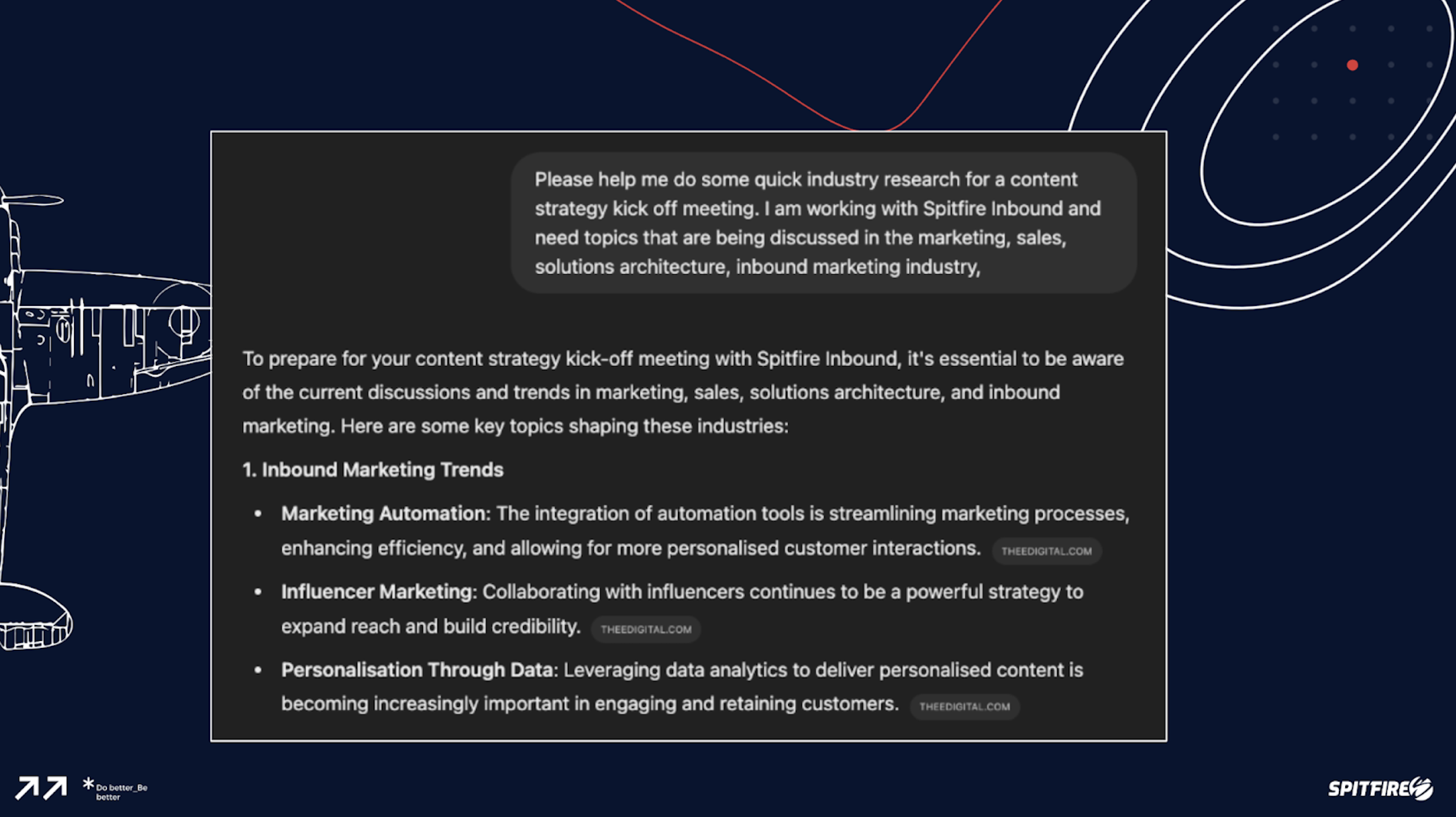
Crafting Impactful Content
Once a strategy is in place, AI can help generate content drafts, saving time in the writing process. AI-powered tools can take key points, audience details, and preferred formats and turn them into draft articles, social media posts, or even video scripts.
AI can generate content quickly, but that doesn’t mean it’s ready to publish. Often, the first draft lacks depth, nuance, or a strong narrative. For instance, when crafting a thought leadership blog, AI can create an initial framework, suggesting headlines, subtopics, and supporting arguments.
This gives writers a strong foundation to build upon, allowing them to focus on strategically shaping and then adding nuance and emotional depth into the message, rather than starting from scratch. Essential to success in this framework is a clear, strong prompt. The strategist sets the direction, AI can critique or expand it, and the writer ensures quality, nuance, and storytelling. In this way, AI works best as a starting point, not an end solution.
After finalising the content strategy, I conducted an interview with one of our experts.
Instead of giving AI an open-ended instruction to create a brief from the interview (which risks a poor output), I used best practice, which is to provide clear context: specify the article’s objective, define the audience, and ask for a few structured options to choose from:
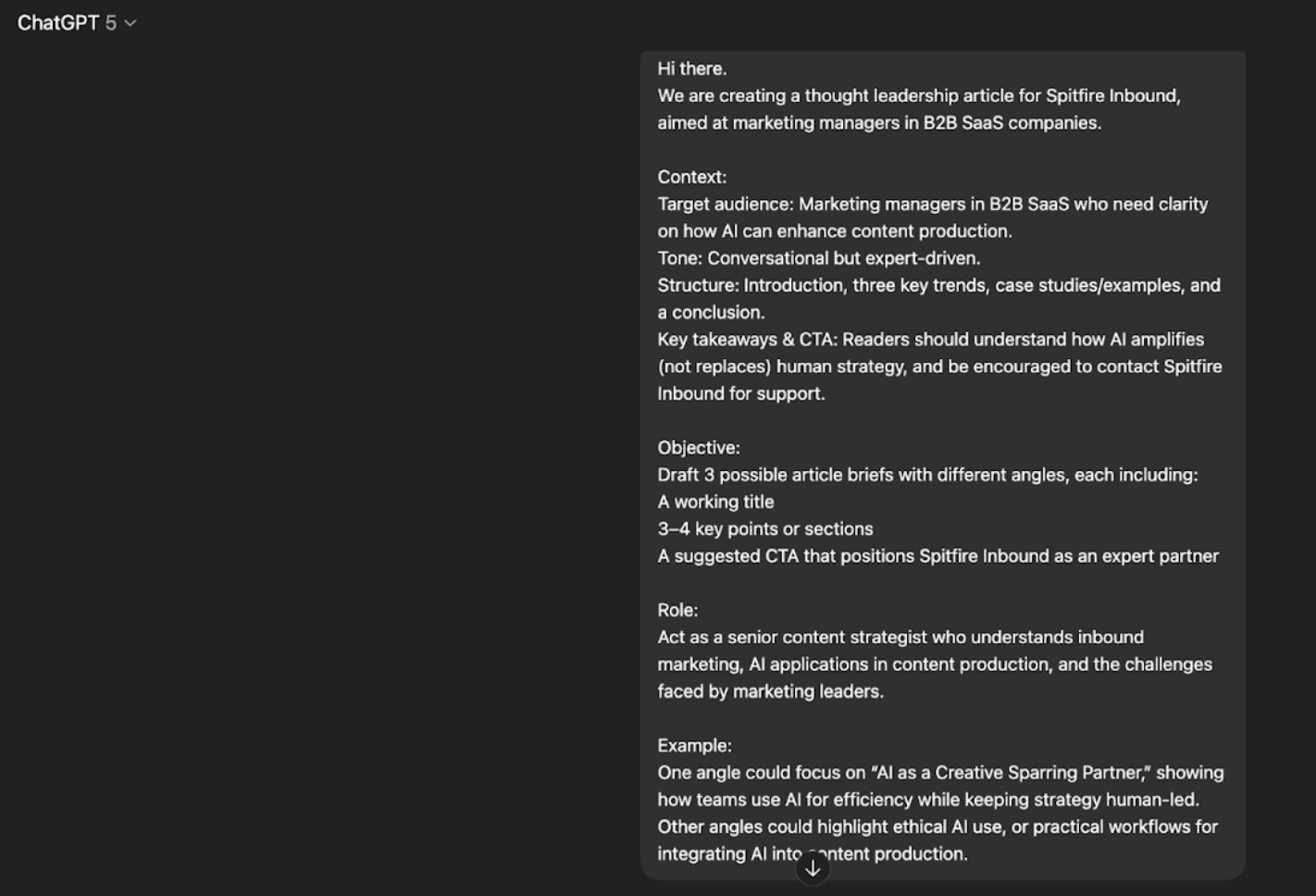
Here’s the output I got:
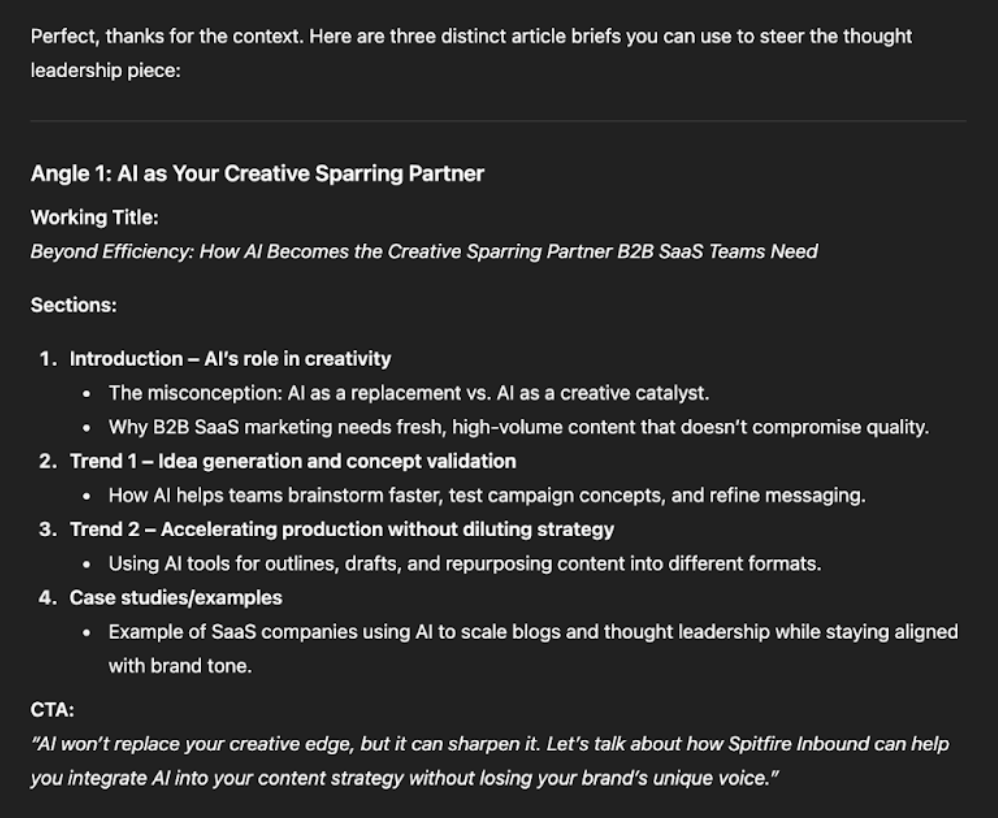
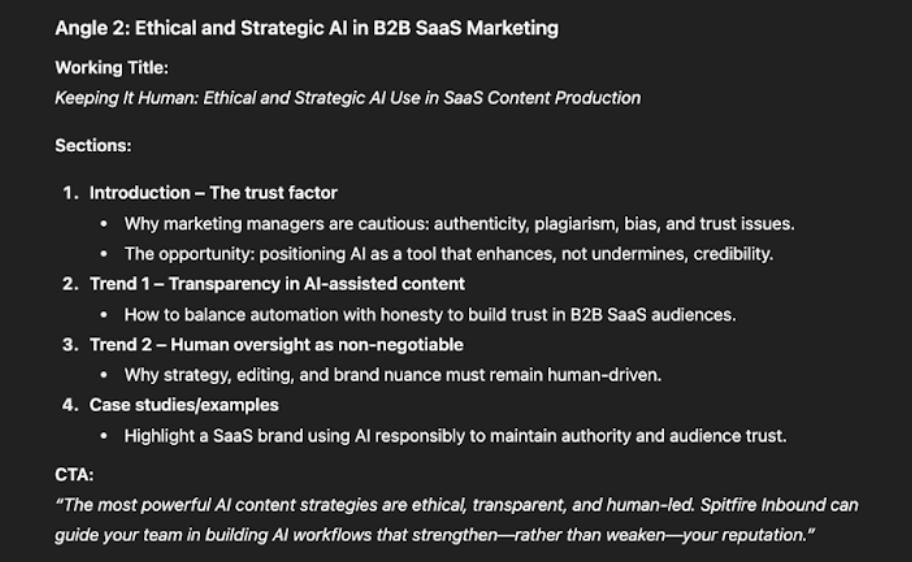
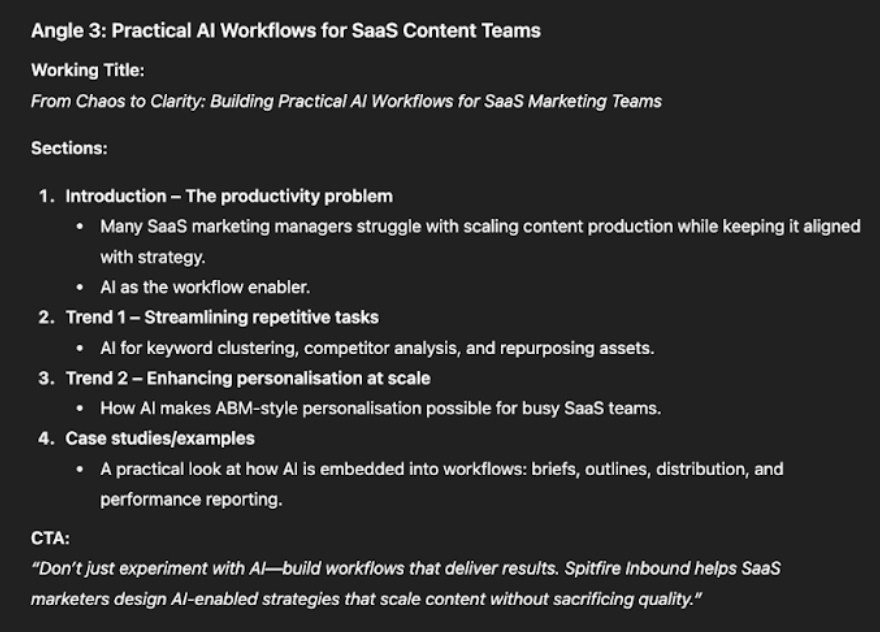
At this stage, the strategist wouldn’t simply pick one brief and run with it. Instead, we would refine the outputs, selecting the strongest option (e.g., Option 1 for its “sparring partner” positioning) and merging or adapting useful points from the others (like ethics from Option 2 or workflows from Option 3). This refinement step ensures the final outline is not just AI-generated but strategically sound and aligned with the content (and business) goals.
Refining and Elevating Content with AI
While AI-generated drafts are a great starting point, they require fine-tuning to ensure accuracy, brand alignment, and engagement. AI tools can assist in improving readability, rephrasing sections for clarity, and even suggesting more compelling headlines.
Tools like HubSpot’s Breeze Content Agent in Content Hub can help writers review content for alignment with brand voice, which keeps your content consistent and aligned with the brand’s unique personality. Another great feature is sentiment analysis, which can assess tone and suggest adjustments to match the desired emotional impact. This helps keep content polished, professional, and consistent.
Here’s a brief overview of how the Breeze Content Agent can help you create blog content:
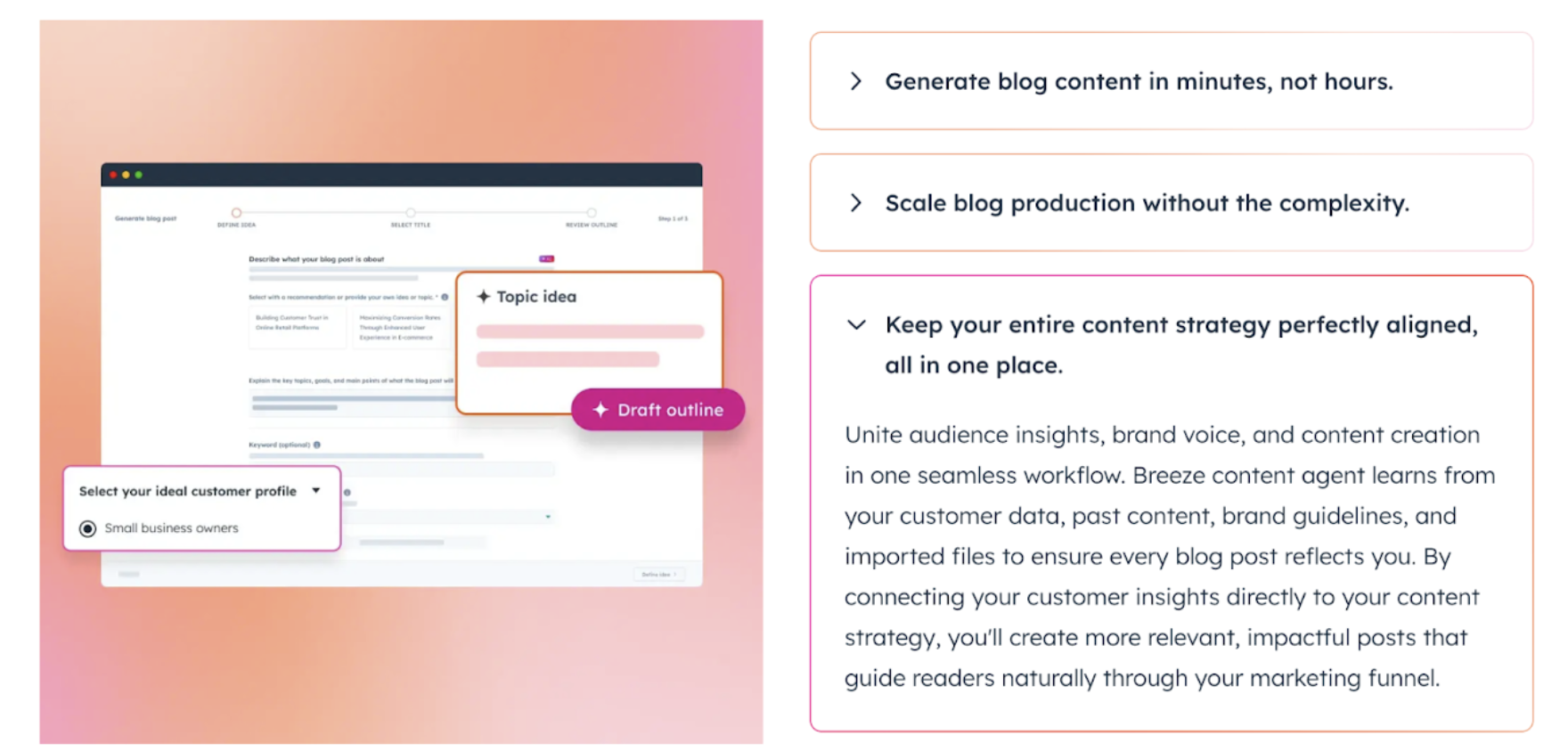
Breeze can also help you create landing pages, website pages, email content, and even podcasts.
Tailoring Content for Different Channels
Content isn’t just about writing, though. It needs to be adapted for different platforms and audiences. AI can adapt long-form content into tailored pieces for multiple platforms, making content distribution more efficient. Blog posts can be broken down into engaging LinkedIn articles, X (Formerly Twitter) threads, or Instagram captions, ensuring that messaging remains consistent but optimised for different audiences.
For example, AI can analyse a blog post and generate social media snippets with platform-specific formatting, character limits, and calls to action. This saves marketers time and ensures a cohesive multi-channel presence.
Tools like HubSpot’s Content Remix automate some of this process, but prompts still need to be carefully crafted.
Here’s a glimpse of how HubSpot’s Content Remix can be used:
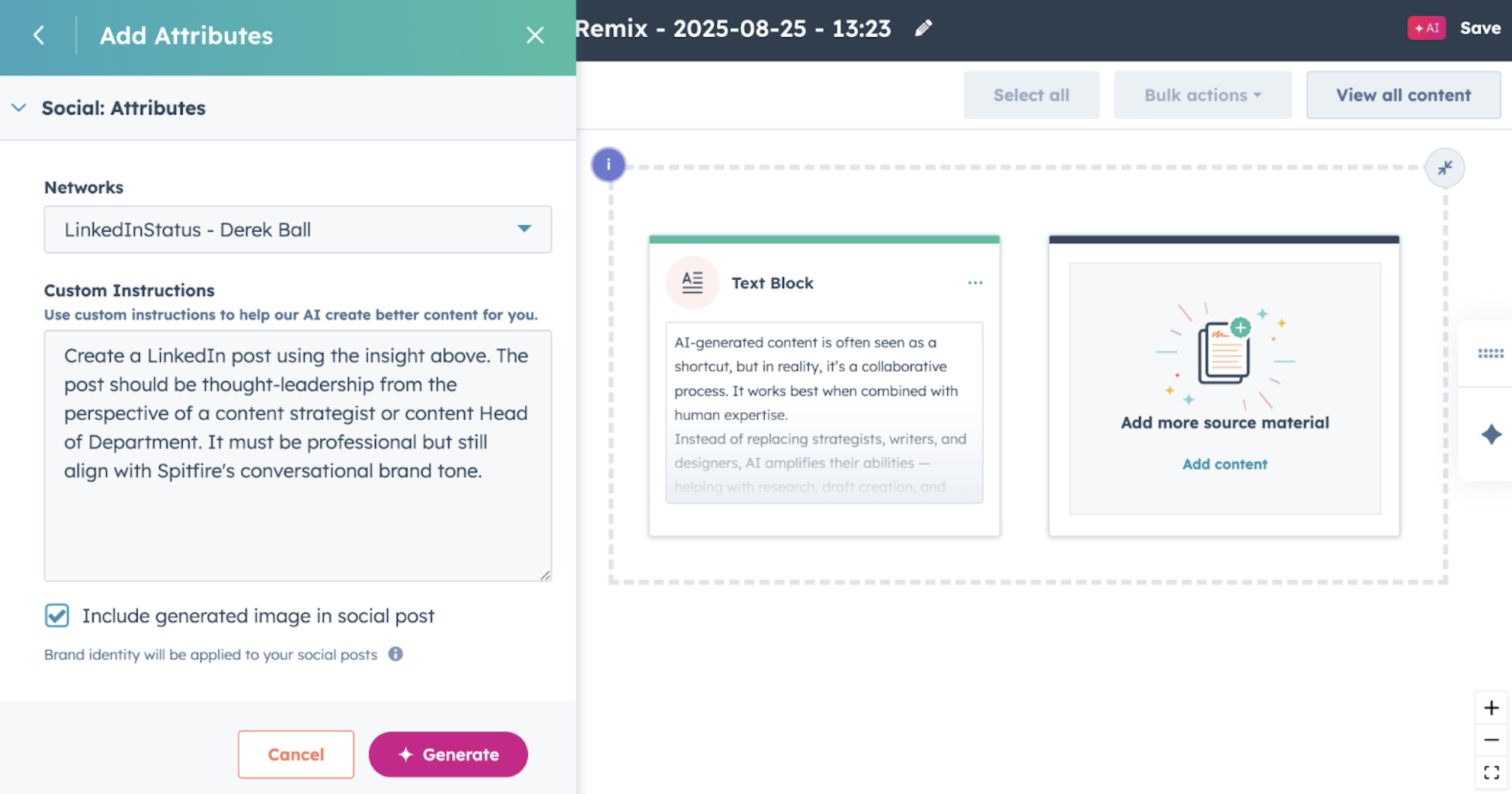
Here's the output:
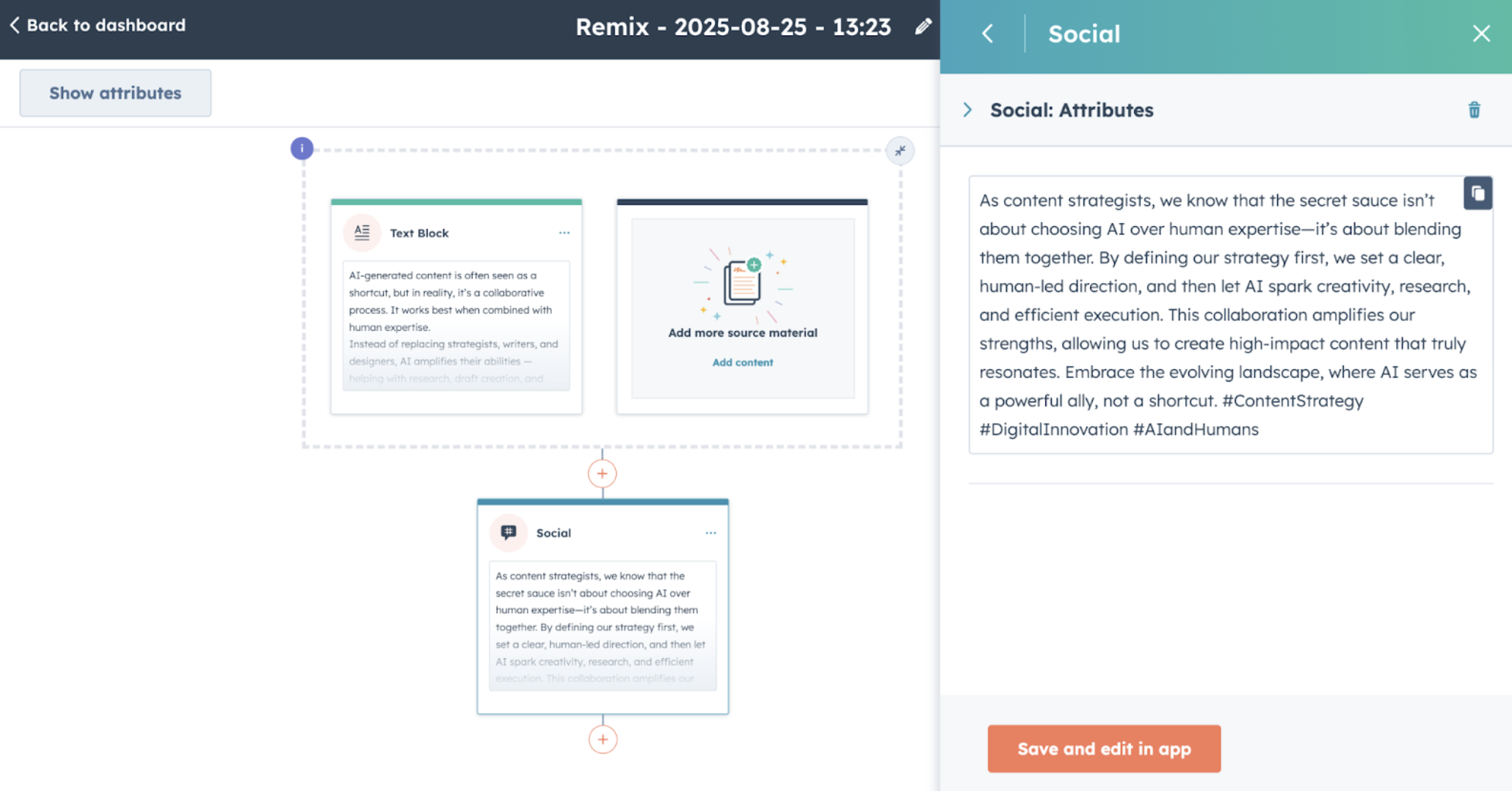
Here's another example:
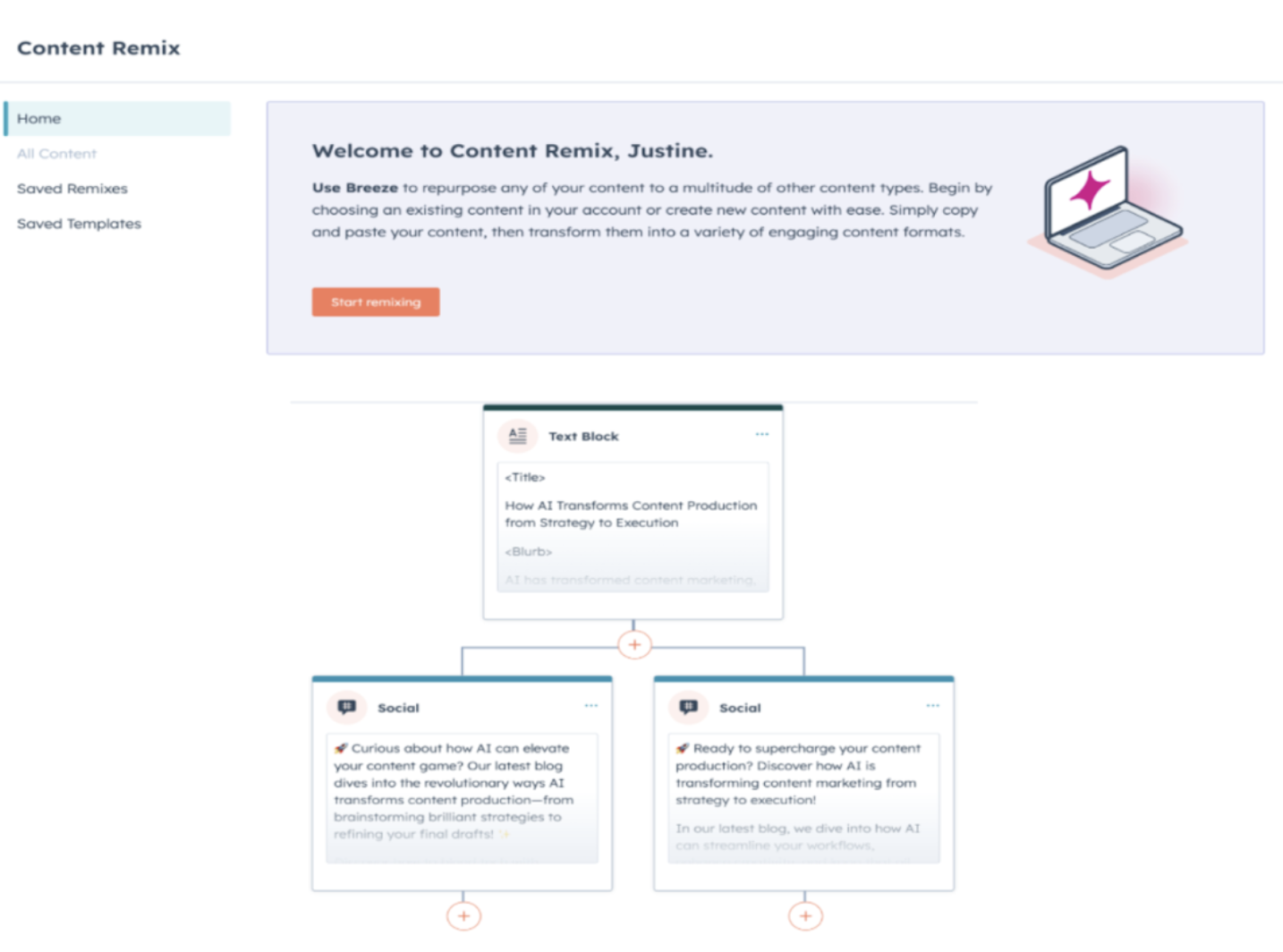
Creating Content That Nurtures Your Audience
Great content doesn’t just sit on a single blog; it can work across channels and platforms. As part of a cohesive content strategy, blog content guides readers through a journey. AI can assist by generating related assets, like landing pages or email sequences, to nurture leads further. For example, if someone downloads a content offer, AI can draft a series of follow-up emails that guide them toward deeper engagement, whether through additional content, webinars, or sales conversations.
AI-driven personalisation can also enhance these emails, tailoring subject lines, messaging, and timing based on user behaviour and preferences. This approach can lead to higher open rates (up to a 41% increase) and higher conversion rates (up to a 42% increase) for many businesses.
AI-generated content is often seen as a shortcut, but in reality, it’s a collaborative process! It works best when combined with human expertise. It’s not meant to replace writers, designers, or strategists; it’s here to amplify their capabilities. By incorporating AI throughout the content production process, teams can create content faster, optimise distribution, and ensure their messaging is always relevant, consistent, and engaging.
When used ethically, efficiently, and strategically, AI enables content teams to focus on what matters most: crafting meaningful, high-impact content that resonates with audiences.
From strategy to execution, AI can boost your content creation process.
Contact us today to learn more about the AI tools we use for content creation!
FAQs
Does AI content production replace the need for a content strategist?
No! AI is a tool that supports strategists, writers, and marketers. Strategy must remain human-led, while AI assists with research, drafts, and refinement in AI content marketing.
What is the most important factor in successful AI content production?
Strong prompting. The quality of output depends on clear context, objectives, and structure defined by the strategist. This ensures AI is always supporting the content strategy, not driving it.
Can AI create content for every channel automatically?
AI can repurpose long-form content for multiple channels (blogs, LinkedIn, X, email, landing pages, etc.), but prompts must be carefully crafted. Human review is essential to keep AI content production aligned with the overall content strategy.
How should businesses measure success with AI content production?
Instead of focusing only on traffic, look at broader metrics such as engagement, lead nurturing effectiveness, alignment with content strategy, and visibility across both SEO and Generative Engine Optimisation (GEO) platforms.
Read our blog about the Next Chapter of Search: From SEO to GEO for more specific insights.
